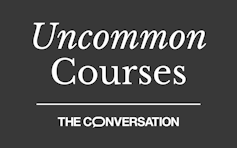Amid growth in AI writing tools, this course teaches future lawyers and other professionals to become better editors
Last updated on April 5th, 2024 at 10:19 pm

Patrick Barry, University of Michigan

Uncommon Courses is an occasional series from The Conversation U.S. highlighting unconventional approaches to teaching.
Title of Course:
“Editing and Advocacy”
What prompted the idea for the course?
In part, I wanted to improve the career prospects of the law students, business students and other aspiring professionals I teach. People who can consistently improve the sentences and paragraphs that come across their desk each day have the opportunity to improve the way ideas and messages are communicated. Who wouldn’t want to add someone like that to their company, government agency or nonprofit organization?
Mostly, though, I designed the course so that my students can experience the empowering magic that comes with being able to take a string of words — whether drafted by themselves or somebody else — and transform them into a revised version that is undeniably better than the original.
What does the course explore?
Students edit emails. They edit contracts. They edit memos, articles, speeches, proposals, text messages, blog posts — pretty much anything that lawyers and other professionals compose. Sometimes they edit alone. Other times they edit as part of a team. But the goal is always the same: learn and practice a skill that is fundamental to becoming an excellent advocate.
Why is this course relevant now?
I first starting teaching “Editing and Advocacy” a few years before the launch of ChatGPT and other generative AI tools. But now that those tools have significantly reduced the cost of producing drafts, the course’s focus on revising drafts — for accuracy, for clarity, for persuasive power — has taken on a newfound relevance.
For instance, when asked how AI might affect what he and other members of the knowledge economy do, tech journalist Charlie Warzel suggested that “the greatest skill that we can all have now is to be ‘editors.’” We may, he noted, start to spend an increasing amount of time correcting and refining AI-produced material.
Ilona Logvinova, associate general counsel and head of innovation for the legal department at consulting giant McKinsey, made a similar point, telling attendees at a recent conference on the use of AI in law: “I really believe that we’re at a moment where we, as lawyers, can transition from being ‘drafters’ to being ‘editors.’”
What’s a critical lesson from the course?
One of the most critical lessons is something I put front and center on the syllabus: “Good editors don’t just see the sentence that was written. They see the sentence that might have been written. They know how to spot words that shouldn’t be included and summon up ones that haven’t yet appeared. Their value comes not just from preventing mistakes but also from discovering new ways to improve a piece’s style, structure, and overall impact.”
The current generation of AI tools is really good at proofreading. But so far, I haven’t encountered any large language model that has the vision, empathy and deep understanding of both context and nuance — not to mention of personal voice —required of a truly exceptional editor.

That doesn’t mean that a technology with those capacities won’t eventually develop, nor that the technology we already have can’t provide enormously useful editing assistance. In fact, more and more of my assignments in “Editing and Advocacy” give students a chance to play around with ChatGPT-like tools. I have also created an entirely separate course called “Digital Lawyering: Advocacy in the Age of AI” that explores the possibilities – and pitfalls – of using artificial intelligence as a kind of co-counsel.
But as I often remind students in both classes, editing is as much about imagination, emotional intelligence and restraint as it is about syntax, semicolons and subject-and-verb agreement. A good way to become better at it is to cultivate the parts of you that are most human.
What materials does the course feature?
Hoping to save my students some money — and wanting to make the materials of the course easily available online — I worked with the publishing team at the University of Michigan to create a set of open-access books that anyone with an internet connection can read for free. These include “Editing and Advocacy,” “Notes on Nuance,” “Punctuation and Persuasion” and “Feedback Loops: How to Give and Receive High-Quality Feedback.”
What will the course prepare students to do?
Editing involves reliably making informed, value-creating decisions. You need to know what to add. You need to know what to delete. You need to know what to separate, combine and rearrange. Students in the course study, evaluate and regularly participate in those types of decisions. In the process, they develop an extremely important and highly transferable skill: good judgment.
Patrick Barry, Clinical Assistant Professor and Director of Digital Academic Initiatives (University of Michigan Law School) | Visiting Lecturer (University of Chicago Law School) | Visiting Lecturer (UCLA School of Law), University of Michigan
This article is republished from The Conversation under a Creative Commons license. Read the original article.


